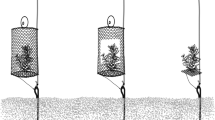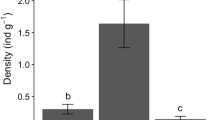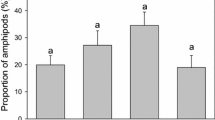Abstract
Amphipods along the western Antarctic Peninsula appear to gain refuge from predators by associating with chemically defended macroalgae rather than palatable macroalgae. However, nothing is known about amphipod activity at night. If foraging on non-chemically defended macroalgae regularly occurs, then nocturnal foraging seems beneficial since visual predators are disadvantaged. To test this hypothesis, we collected three common macroalgal species and affiliated mesograzers, approximately 3 h before and after sunset. All associated mesofauna were counted and densities recorded. Amphipod densities were significantly decreased during the night on the chemically defended Desmarestia menziesii, while significantly increased on the palatable Iridaea cordata. Additionally, the amphipod Gondogeneia antarctica was found in significantly higher densities at night on Palmaria decipiens, a species shown to be readily eaten by G. antarctica and omnivorous fish. We believe that chemically defended macroalgae act as a refuge for mesograzers during the day, while more widespread foraging occurs at night.


Similar content being viewed by others
References
Alldredge AL, King JM (1980) Effects of moonlight on the vertical migration patterns of demersal zooplankton. J Exp Mar Biol Ecol 44:133–156
Amsler CD, Rowley RJ, Laur DR, Quetin LB, Ross RM (1995) Vertical distribution of Antarctic peninsular macroalgae: cover, biomass and species composition. Phycologia 34:424–430
Amsler CD, Iken K, McClintock JB, Amsler MO, Peters KJ, Hubbard JM, Furrow FB, Baker BJ (2005) Comprehensive evaluation of the palatability and chemical defenses of subtidal macroalgae from the Antarctic Peninsula. Mar Ecol Prog Ser 294:141–159
Amsler CD, McClintock JB, Baker BJ (2008) Macroalgal chemical defenses in polar marine communities. In: Amsler CD (ed) Algal chemical ecology. Springer, Berlin, pp 91–100
Amsler CD, Amsler MO, McClintock JB, Baker BJ (2009a) Filamentous algal endophytes in macrophytic Antarctic algae: prevalence in hosts and palatability to mesoherbivores. Phycologia 48:324–334
Amsler MO, McClintock JB, Amsler CD, Angus RA, Baker BJ (2009b) An evaluation of sponge-associated amphipods from the Antarctic Peninsula. Antarct Sci 21:579–589
Aumack CF, Amsler CD, McClintock JB, Baker BJ (2010) Chemically mediated resistance to mesoherbivory in finely branched macroalgae along the western Antarctic Peninsula. Eur J Phycol 45:19–26
Aumack CF, Amsler CD, McClintock JB, Baker BJ (2011) Impacts of mesograzers on epiphyte and endophyte growth associated with chemically defended macroalgae from the Western Antarctic Peninsula: a mesocosm experiment. J Phycol 47:36–41
Bell SS (1991) Amphipods as insect equivalents? An alternative view. Ecology 72:350–354
Bernays EA, Chapman RF (1994) Host-plant selection by phytophagous insects. Chapman & Hall, New York
Bernays E, Graham M (1988) On the evolution of host specificity in phytophagous arthropods. Ecology 69:886–892
Brawley SH (1992) Mesoherbivores. In: John DM, Hawkins SJ, Price JH (eds) Plant-animal interactions in the Marine Benthos. Clarendon Press, Oxford, pp 235–263
Bucolo P, Amsler CD, McClintock JB, Baker BJ (2011) Palatability of the Antarctic rhodophyte Palmaria decipiens (Reinsch) RW Ricker and its endo/epiphyte Elachista antarctica Skottsberg to sympatric amphipods. J Exp Mar Biol Ecol 396:202–206
Buschmann AH (1990) Intertidal macroalgae as refuge and food for amphipoda in central Chile. Aquat Bot 36:237–245
Donatti L, Fanta E (2002) Influence of photoperiod on visual prey detection in the Antarctic fish Notothenia neglecta. Antarct Sci 14:146–150
Duffy JE, Hay ME (1991) Food and shelter as determinants of food choice by a herbivorous marine amphipod. Ecology 72:1286–1298
Duffy JE, Hay ME (1994) Herbivore resistance to seaweed chemical defense: the roles of mobility and predation risk. Ecology 75:1304–1319
Edgar GJ (1983) The ecology of south-east Tasmanian phytal animal communities. I. Spatial organization on a local scale. J Exp Mar Biol Ecol 70:129–157
Forward RB, Wyatt L, Clifford D, Barbour A (2007) Endogenous rhythm in activity of an estuarine amphipod, Talorchestia longicornis. Mar Freshw Behav Physiol 40:133–140
Franz DR, Mohamed Y (1989) Short-distance dispersal in a fouling community amphipod crustacean, Jassa marmorata Holmes. J Exp Mar Biol Ecol 133:1–13
Grabe SA (1996) Composition and seasonality of nocturnal peracarid zooplankton from coastal New Hampshire (USA) waters, 1978–1980. J Plankton Res 18:881–894
Greening HS, Livingston RJ (1982) Diel variation in the structure of seagrass-associated epibenthic macroinvertebrate communities. Mar Ecol Prog Ser 7:147–156
Hay ME (1996) Marine chemical ecology: what’s known and what’s next? J Exp Mar Biol Ecol 200:103–134
Hay ME, Steinberg PD (1992) The chemical ecology of plant-herbivore interactions in marine versus terrestrial communities. In: Rosenthal GA, Berenbaum M (eds) Herbivores: their interaction with secondary plant metabolites. Academic Press, San Diego, pp 371–413
Hay ME, Duffy JE, Fenical W (1990) Host-plant specialization decreases predation on a marine amphipod—an herbivore in plants clothing. Ecology 71:733–743
Huang YM, McClintock JB, Amsler CD, Peters KJ, Baker BJ (2006) Feeding rates of common Antarctic gammarid amphipods on ecologically important sympatric macroalgae. J Exp Mar Biol Ecol 329:55–65
Huang YM, Amsler MO, McClintock JB, Amsler CD, Baker BJ (2007) Patterns of gammaridean amphipod abundance and species composition associated with dominant subtidal macroalgae from the western Antarctic Peninsula. Polar Biol 30:1417–1430
Ide K, Takahashi K, Nakano T, Sato M, Omori M (2006) Chemoreceptive foraging in a shallow-water scavenging lysianassid amphipod: role of amino acids in the location of carrion in Scopelocheirus onagawae. Mar Ecol Prog Ser 317:193–202
Iken K, Barrera-Oro ER, Quartino ML, Casaux RJ, Brey T (1997) Grazing by the Antarctic fish Notothenia coriiceps: evidence for selective feeding on macroalgae. Antarct Sci 9:386–391
Iken K, Quartino ML, Wiencke C (1999) Histological identification of macroalgae from stomach contents of the Antarctic fish Notothenia coriiceps using semi-thin sections. Mar Ecol 20:11–17
Martin-Smith KM (1994) Short-term dynamics of tropical macroalgal epifauna: patterns and processes in recolonisation of Sargassum fissifolium. Mar Ecol Prog Ser 110:177–185
Nair KKC, Anger K (1980) Seasonal variation in population structure and biochemical composition of Jassa falcata (Crustacea, Amphipoda) off the island of Helgoland (North-Sea). Est Coast Mar Sci 11:505–513
Poore AGB, Steinberg PD (1999) Preference-performance relationships and effects of host plant choice in an herbivorous marine amphipod. Ecol Monogr 69:443–464
Poore AGB, Watson MJ, de Nys R, Lowry JK, Steinberg PD (2000) Patterns of host use among alga- and sponge-associated amphipods. Mar Ecol Prog Ser 208:183–196
Richardson MG (1977) The ecology (including physiological aspects) of selected Antarctic marine invertebrates associated with inshore macrophytes. PhD Dissertation. Department of Zoology, Durham
Schneider FI, Mann KH (1991) Species specific relationships to vegetation in a seagrass bed. II. Experiments on the importance of macrophyte shape, epiphyte cover and predation. J Exp Mar Biol Ecol 145:101–117
Scinto A, Benvenuto C, Cerrano C, Mori M (2007) Seasonal cycle of Jassa marmorata Holmes, 1903 (Amphipoda) in the Ligurian Sea (Mediterranean, Italy). J Crustac Biol 27:212–216
Taylor RB (1998) Short-term dynamics of a seaweed epifaunal assemblage. J Exp Mar Biol Ecol 227:67–82
Taylor RB, Steinberg PD (2005) Host use by Australasian seaweed mesograzers in relation to feeding preferences of larger grazers. Ecology 86:2955–2967
Wahl M, Hay ME (1995) Associational resistance and shared doom—effects of epibiosis on herbivory. Oecologia 102:329–340
Zamzow JP, Amsler CD, McClintock JB, Baker BJ (2010) Habitat choice and predator avoidance by Antarctic amphipods: the roles of algal chemistry and morphology. Mar Ecol Prog Ser 400:155–163
Acknowledgments
We thank Maggie Amsler, Philip Bucolo, Alan Maschek, Dr. Jill Zamzow, and the rest of our 2007 and 2008 Antarctic field team colleagues for their field assistance. This project would not have been possible without the hard work and outstanding logistical support in Antarctica from the employees and sub-contractors of Raytheon Polar Services Company. This work was supported by National Science Foundation awards OPP-0442769 (CDA, JBM) and OPP-0442857 (BJB) from the Antarctic Ecosystems and Organisms program and by an Endowed Professorship in Polar and Marine Biology to JBM provided by the University of Alabama at Birmingham.
Author information
Authors and Affiliations
Corresponding author
Additional information
Communicated by S. D. Connell .
Rights and permissions
About this article
Cite this article
Aumack, C.F., Amsler, C.D., McClintock, J.B. et al. Changes in amphipod densities among macroalgal habitats in day versus night collections along the Western Antarctic Peninsula. Mar Biol 158, 1879–1885 (2011). https://doi.org/10.1007/s00227-011-1700-0
Received:
Accepted:
Published:
Issue Date:
DOI: https://doi.org/10.1007/s00227-011-1700-0




